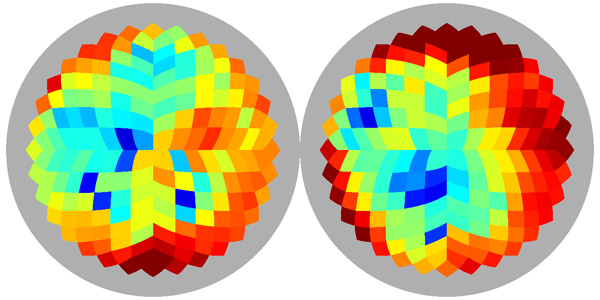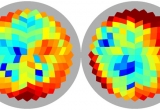Planck reveals the dusty screen veiling the polarization of the CMB
The Planck consortium has published a statistical analysis of the dust polarization towards the regions of the sky best suited to measure Cosmic Microwave Background polarization. This work shows that dust polarization is significant over all of the sky, and that the signature of cosmic inflation will not be detected unless contamination associated with the dusty and magnetized interstellar medium in the Galaxy is removed with the required accuracy and confidence.
The publication, which is the result of the continuing work of IAS on the Planck project from instrument design to data analysis, questions the interpretation of the signal reported by BICEP2 earlier this year. This signal was initially assumed as arising primarily from primordial gravitational waves produced during inflation, an early era of exponential expansion of the universe, but is now likely that the significance of this detection will be reduced, possibly significantly.
Inflation has been proposed to explain why the universe we see is apparently nearly uniform in all directions. A key prediction of inflation is that it generated gravitational waves. The corresponding ripples in the space-time fabric left an imprint in the polarization of the Cosmic Microwave Background, referred to as B-mode polarization. Planck, as well as balloon-borne and ground based facilities, are taking a major step towards the measurement of this signal by mapping the microwave sky polarization with an unprecedented sensitivity. However, unlike for temperature anisotropies, Galactic foregrounds may have a much larger amplitude than the putative primordial signal.

Map of the dust B-mode polarization, as estimated from the Planck data, in units of the signal expected from primordial
gravitational waves. The green color corresponds to a Galactic signal comparable to the signal detected by the BICEP2
experiment over the sky patch marked with a black contour.
Blue and red colours identify regions of fainter and brighter dust polarization. Credits : ESA & Planck collaboration
Contacts at the IAS: Jonathan Aumont & François Boulanger
Link: https://arxiv.org/abs/1409.5738
sur planck.fr:
http://public.planck.fr/actualites-planck/244-planck-revele-l-ecran-de-poussiere-polarisee-devant-le-rayonnement-fossile
Le Monde:
https://www.lemonde.fr/sciences/article/2014/09/22/des-poussieres-brouillent-l-echo-du-big-bang_4491761_1650684.html
New York Times:
https://www.nytimes.com/2014/09/23/science/space/study-confirms-criticism-of-big-bang-finding.html?_r=0
Washington Post:
https://www.washingtonpost.com/news/achenblog/wp/2014/09/22/planck-satellite-shows-bicep2-telescope-make-have-seen-dust-not-the-big-bang/
BBC:
https://www.bbc.com/news/science-environment-29305985
Nature:
https://www.nature.com/articles/nature.2014.15975




